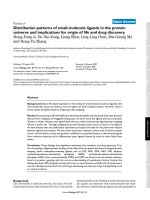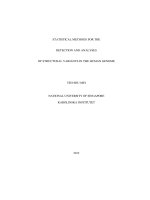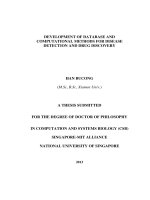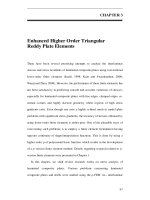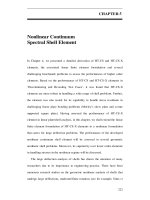Development of database and computational methods for disease detection and drug discovery
Bạn đang xem bản rút gọn của tài liệu. Xem và tải ngay bản đầy đủ của tài liệu tại đây (5.71 MB, 213 trang )
DEVELOPMENT OF DATABASE AND
COMPUTATIONAL METHODS FOR DISEASE
DETECTION AND DRUG DISCOVERY
HAN BUCONG
(M.Sc, B.Sc, Xiamen Univ.)
A THESIS SUBMITTED
FOR THE DEGREE OF DOCTOR OF PHILOSOPHY
IN COMPUTATION AND SYSTEMS BIOLOGY (CSB)
SINGAPORE-MIT ALLIANCE
NATIONAL UNIVERSITY OF SINGAPORE
2013
I
DECLARATION
I hereby declare that this thesis is my original work and it has been
written by me in its entirety.
I have duly acknowledged all the sources of information which have been
used in the thesis.
This thesis has also not been submitted for any degree in any university
previously
.
Han Bucong
25 January 2013
II
ACKNOWLEDGEMENTS
First and foremost, I would like to present my sincere gratitude to my Singapore
supervisor, Professor Chen Yu Zong, who provides me with excellent guidance,
invaluable advices and suggestions throughout my Ph.D study. I have tremendously
benefited from his profound knowledge, expertise in scientific research, as well as his
enormous support, which will inspire and motivate me to go further in my future
professional career. I was delighted to interact with Professor Bruce Tidor by having
him as my MIT supervisor. His insights, knowledge and great efforts form the strong
support to my adventure in computational biology.
I would also like to thank our present and previous BIDD group members for their
insight suggestions and collaborations in my research work. In particulars, I would
like to thank Dr. Pankaj Kumar, Dr. Liu Xianghui, Dr. Ma Xiaohua, Dr. Jia jia, Dr.
Zhu Feng, Dr. Shi Zhe, Ms Liu Xin, Mr. Zhang Jiangxian, Ms Wei Xiaona etc. and
other previous research staffs. BIDD is like a big family and I really enjoy the close
friendship among us.
Last, but not the least, I am grateful to my parents and my wife for their
encouragement and accompany.
III
TABLE OF CONTENTS
DECLARATION I
ACKNOWLEDGEMENTS II
TABLE OF CONTENTS III
SUMMARY VIII
LIST OF TABLES X
LIST OF FIGURES XII
LIST OF ACRONYMS XIV
Chapter 1 Introduction 1
1.1 Overview of pathogen detection 1
1.1.1 Application areas requiring pathogen detection. 1
1.1.2 Brief introduction to pathogens induced infectious diseases 2
1.1.3 Conventional pathogen detection methods 6
1.1.4 Molecular pathogen detection methods 7
1.2 Bioinformatics and cheminformatics in drug discovery 9
1.3 Introduction of bioinformatics and cheminformatics database development 11
1.4 Overview of virtual screening in drug discovery 15
IV
1.5 Objective and outline of this thesis 27
Chapter 2 Methodology 29
2.1 Database development 29
2.1.1 Database model and rational schema design 29
2.1.2 Data collection 31
2.1.3 Data integration and organization 33
2.1.4 Database management system 35
2.1.5 User Interface 36
2.2 Dataset collection and preprocess for building models 38
2.2.1 Dataset resource 38
2.2.2 Dataset quality 39
2.2.3 Dataset structural diversity 40
2.3 Molecular descriptor 41
2.4 Scaling of molecular descriptors 45
2.5 Machine learning classification methods 46
2.5.1 Support vector machine (SVM) 48
2.5.2 k-nearest neighbors (kNN) 52
2.5.3 Probabilistic neural network (PNN) 54
V
2.5.4 Tanimoto similarity searching method 58
2.5.5 Generation of putative negatives 58
2.6 Virtual screening model optimization, validation and performance
measurements 62
2.6.1 Model optimization and validation 62
2.6.2 Performance evaluation 63
2.6.3 Overfitting problem and its detection 65
Chapter 3 Development of MicrobPad MD: microbial pathogen diagnostic methods
database 66
3.1 Introduction 66
3.2 Database construction 68
3.3 Data collection and access 69
3.4 Database usage and validation 78
3.5 Concluding remarks 80
Chapter 4 Development of TTD: therapeutic target database 82
4.1 Introduction 82
4.2 Target and drug data collection and access 84
4.3 Ways to access therapeutic targets database 86
4.4 Target and drug similarity searching 93
Chapter 5 Development and experimental test of support vector machines virtual
screening method for searching Src inhibitors from large compound libraries 97
5.1 Introduction 97
VI
5.2 Materials and methods 101
5.2.1 Compound collections and construction of training and testing datasets
101
5.3 Results and discussion 104
5.3.1 Performance of SVM, kNN and PNN identification of Src inhibitors
based on 5-fold cross validation test 104
5.3.2 Virtual screening performance of SVM in searching Src inhibitors from
large compound libraries 108
5.3.3 Experimental test of a SVM identified virtual-hit 111
5.3.4 Evaluation of SVM identified MDDR virtual-hits 112
5.3.5 Comparison of virtual screening performance of SVM with those of
other vrtual screening methods 115
5.3.6 Does SVM select Src inhibitors or membership of compound families?
118
5.4 Conclusions 118
Chapter 6 Support vector machines virtual screening of VEGFR-2 Inhibitors from
large compound libraries: model development and experimental test 120
6.1 Background 120
6.2 Materials and methods 123
6.2.1 Compound collections and construction of training and testing datasets
123
6.3 Results and Discussion 127
6.3.1 VEGFR-2 Inhibitor prediction Performance of SVM, kNN and PNN
evaluated by 5-fold cross validation test 127
6.3.2 Virtual screening performance of SVM in searching VEGFR-2
inhibitors from large compound libraries 132
6.3.3 Experimental test of a SVM identified virtual-hit 135
VII
6.3.4 Evaluation of SVM identified MDDR virtual-hits 136
6.3.5 Comparison of virtual screening performance of SVM with
tanimoto-based similarity searching method 140
6.3.6 Does SVM select VEGFR inhibitors or membership of compound
families? 142
6.4 Concluding remarks 142
Chapter 7 Concluding remarks 144
7.1 Major findings and merits 144
7.1.1 Merits of the development of MicrobPad MD: microbial pathogen
diagnostic methods database 144
7.1.2 Merits of the updates of TTD in facilitating multi-target drug discovery .
145
7.1.3 Merits of virtual screening model for Src inhibitors 146
7.1.4 Merits of virtual screening model for VEGFR-2 inhibitors 147
7.2 Limitations and suggestions for future studies 147
Reference 151
Appendices 183
List of publication 195
VIII
SUMMARY
Drug discovery is an expensive and time-consuming process which requires large
amount of financial investment. Efforts in bioinformatics and cheminformatics are
extensively explored to increase the efficiency and reduce costs of drug discovery and
development. Bioinformatics tools such as database and computational methods such
as machine learning method based virtual screening (VS) have been developed for
searching novel lead compounds.
Database development is a promising approach which can accelerate drug discovery
by systematically managing and providing medicinal chemicals and biomolecules
information with a web accessible interface. This information is a useful resource for
further drug discovery application besides a data storing pool. VS is known to
contribute to discovery of hits and lead compounds and VS has been investigated and
explored intensively. Various tools and applications have been developed according
to VS. However, there are many issues of many conventional VS tools including
insufficiency of compound diversity coverage, slow screening speed of large
compound libraries and high false positive rate. It is demanded to overcome these
problems and it would be very useful to develop application of VS tools to discover
novel compounds by screening large compound libraries rapidly at good yields and
low false-hit rates.
IX
In this work, several computational approaches for facilitating disease detection and
drug discovery are presented. MicrobPad MD: Microbial pathogen diagnostic
methods database is built to provide comprehensive information about the molecular
detection for pathogens. It may help accurate, sensitive and low-cost detection of
medical pathogens and diagnosis of disease. The updated TTD is expected to be a
useful resource in complement to other related databases by providing comprehensive
information about the primary targets and drug of the approved, clinical trial, and
experimental drugs. These database lead to a better understanding of the disease and
benefit for drug discovery.
Src promotes tumour invasion and metastasis, and facilitates VEGF-mediated
angiogenesis and survival in endothelial cells. Both Src and VEGFR-2 are very
important for disease, particularly cancers. To facilitate drug discovery by saving time
and cost in developing novel lead, the machine learning methods are used to build
screening models for Src and VEGFR-2 inhibitors. It is shown that SVM based VS
tools work efficiently in the discovery of Src, VEGFR-2 inhibitors and other active
compounds at low false-hit rates. The virtual hits of models have been tested
experimentally to further verify the models. These projects facilitate drug discovery
by reducing the cost and time in developing novel drug lead.
X
LIST OF TABLES
Table 1-1 Four categories of pathogen inducing infectious human disease. Their
infection are briefly described. Examples of the types of pathogens are listed, along
with the disease they cause. 3
Table 1-2 The top 10 leading cause of death worldwide in 2008 reported by WHO
fact sheet. 5
Table 1-3 Three pathogenic diseases mortality rate in 2013. 6
Table 1-4 Popular bioinformatics databases. 12
Table 1-5 Popular chemical databases 14
Table 1-6 Comparison of the reported performance of different VS methods in
screening large libraries of compounds (adopted from Han et al[114]). 23
Table 2-1 98 molecular descriptors used in this work. 43
Table 2-2 Websites that contain codes of machine learning methods 47
Table 5-1
Performance of SVM for identifying Src inhibitors and non-inhibitors
evaluated by 5-fold cross validation study 105
Table 5-2 Performance of kNN for identifying Src inhibitors and non-inhibitors
evaluated by 5-fold cross validation study 106
Table 5-3 Performance of PNN for identifying Src inhibitors and non-inhibitors
evaluated by 5-fold cross validation study 107
Table 5-4 Virtual screening performance of support vector machines for identifying
Src inhibitors from large compound libraries 109
Table 5-5 MDDR classes that contain higher percentage (≥3%) of SVM virtual-hits
and the percentage values. Virtual-hits are identified by SVMs in screening 168K
MDDR compounds for Src inhibitors. The total number of SVM identified virtual hits
is 1,496. 113
Table 5-6 Comparison of virtual screening performance of SVM with those of other
methods 117
XI
Table 6-1 Performance of SVM for identifying VEGFR-2 inhibitors and
non-inhibitors evaluated by 5-fold cross validation study 129
Table 6-2 Performance of kNN for identifying VEGFR-2 inhibitors and
non-inhibitors evaluated by 5-fold cross validation study. 130
Table 6-3 Performance of PNN for identifying VEGFR-2 inhibitors and
non-inhibitors evaluated by 5-fold cross validation study. 131
Table 6-4 Virtual screening performance of support vector machines for identifying
VEGFR-2 inhibitors from large compound libraries 133
Table 6-5 MDDR classes that contain higher percentage (≥3%) of SVM virtual-hits
and the percentage values. Virtual-hits are identified by SVMs in screening 168K
MDDR compounds for VEGFR-2 inhibitors. The total number of SVM identified
virtual hits is 2,717. 137
Table 6-6 Comparison of virtual screening performance of SVM with those of other
methods 141
XII
LIST OF FIGURES
Figure 1-1 SBVS and LBVS for drug discovery procedure (adopted from Ref [76]).
SBVS is shown on the left and LBVS is shown on the right. 18
Figure 2-1 Schematic diagram of the process of the training a prediction model and
using it for predicting active compounds of a compound class from their
structurally-derived properties (molecular descriptors) by using support vector
machines; A, B, E, F and (hj, pj, vj,…) represents such structural and
physicochemical properties as hydrophobicity, volume, polarizability, etc. 51
Figure 2-2 Schematic diagram illustrating the process of the prediction of compounds
of a particular property from their structure by using k-nearest neighbors (kNN).
Feature vector (hj, pj, vj,…) represents such structural and physicochemical properties
as hydrophobicity, volume, polarizability, etc; green dots: agents with the property;
black box : agents without the property. 53
Figure 2-3 Schematic diagram illustrating the process of the prediction of compounds
of a particular property from their structure by using probabilistic neural networks
(PNN). A, B: feature vectors of agents with the property; E, F: feature vectors of
agents without the property; feature vector (h
j
, p
j
, v
j
,…) represents such structural and
physicochemical properties as hydrophobicity, volume, polarizability, etc. 57
Figure 3-1 Home page of MicrobPad MD database 72
Figure 3-2 Customized search page. This page provides search fields of genus name,
species name, target name, disease indication and virulence factor. 73
Figure 3-3 List result page. This page provides genus name, species name, virulence
factor, target gene, disease indications, and the number of diagnostic methods. 74
Figure 3-4 Related species and diagnostic methods page. This page provides detailed
description about the related species and the diagnostic methods. 75
Figure 3-5 Data download page of MicrobPad MD database 76
Figure 3-6 Data upload page of MicrobPad MD database 77
Figure 4-1 Home page of TTD 2010 87
XIII
Figure 4-2 Customized search page of TTD 2010 88
Figure 4-3 Sequence similarity search page of TTD 2010 88
Figure 4-4 Drug tanimoto similarity search page of TTD 2010 89
Figure 4-5 Targets list page of “VEGFR” 90
Figure 4-6 TTD target detail information page 91
Figure 4-7 TTD drug detail information page 92
Figure 5-1 The structures of representative c-Src inhibitors. Comppound 1:SKI-606
IC50=0.25µm [144]; Compound 2: AG-1879, IC50=0.085µm; Compound 3:
Sunitinib, SU 11248, IC50=1µm [282]; Compound 4: IC50=0.5µm [280]; Compound
5: IC50=0.26µm [281]; Compound 6: IC50=0.001µm [282]. 102
Figure 5-2 The 5-fold cross-validation studies of Src inhibitors across methods with
the averaged sensitivity together with their respective error bars. 108
Figure 5-3 Virtual hit inhibiting Src at a moderate rate of 4.85% at 20µM 112
Figure 6-1 The structures of representative VEGFR-2 inhibitors. Compound 1:
Sunitinib,IC50=0.009µm,; Compound 2:IC50=0.032µm [335]; Compound 3:Vatalanb
(PTK787), IC50=0.037µm; Compound 4: IC50=0.012µm [336]; Compound 5:
IC50=0.004 µm [337]; Compound 6:IC50=0.111µm[338]. 125
Figure 6-2 Performance for identifying VEGFR-2 inhibitors evaluated by 5-fold cross
validation study across methods. This figure is illustrating the 5-fold cross validation
studies of VEGFR-2 inhibitors across methods with the averaged sensitivity together
with their respective error bars. 132
Figure 6-3 The structure of a SVM virtual hit tested to show moderate VEGFR-2
inhibitory activity. 136
XIV
LIST OF ACRONYMS
FN
False negative
FP
False positive
HTS
High throughput screening
k-NN
k-nearest neighbors
LBVS
Ligand-based Virtual Screening
Lck
Lymphocyte-specific protein tyrosine kinase
MCC
Matthews correlation coefficient
MDDR
MDL Drug Data Report
ML
Machine Learning
MicrobPad MD
Microbial Pathogen Diagnostic Methods Database
PNN
Probabilistic neural network
SBVS
Structure-based Virtual Screening
Src
Tyrosine-protein kinase Src
Std Dev
Standard Deviation
Std Err
Standard Error
SVM
Support vector machine
TN
True negative
TP
True positive
XV
TTD
Therapeutic targets database
VS
Virtual Screening
VEGFR-2
Vascular endothelial growth factor receptor 2
1
Chapter 1 Introduction
Disease detection and drug discovery is typically a costly and lengthy process which
takes more than 10 years to develop a successful drug from initial design to market.
Although a log of efforts have been made for drug discovery, the successful drugs did
not increase significantly over the past few decades. Bioinformatics and
cheminformatics tools are explored to make drug research and development more
efficient and effective. To help achieve this purpose, this work on "Development of
Database and Computational Methods for Disease Detection and Drug Discovery" is
conducted as one of the strategies illustrated in this chapter. The thesis contains
database development of disease detection and therapeutic targets as well as
discovery of potential drug lead by silico virtual screening. This introduction chapter
includes: (1) conventional and molecular detection methods of pathogen; (2)
bioinformatics and cheminformatics in drug discovery; (3) database development; (4)
virtual screening of drug discovery; (5) objectives and outlines.
1.1 Overview of pathogen detection
1.1.1 Application areas requiring pathogen detection.
The detection of pathogens is the most important procedure for the identification and
prevention of health and safety problems. It will cause terrible consequences in some
2
areas especially in clinical diagnostics, environment quality control and food industry
where failure to detect pathogens. The pathogen detection has become the critical part
in many research areas and application areas including pathology research, disease
diagnosis, biodefense, food and water safety and epidemic prevention. Three
application areas account for over two thirds of all research in the field of pathogen
detection including food industry, water and environment quality control and clinical
diagnosis [1-3]. Particularly in European Union, about 275 million pathogen detection
of food were conducted in 2011 and this number in 2016 will to get to 350 million [4].
1.1.2 Brief introduction to pathogens induced infectious diseases
A biological agent that cause diseases to its host is known as pathogen. Pathogens are
most often used to refer to numerous infectious microorganisms such as bacteria,
viruses, fungi and parasites which infect unicellular or multicellular organisms
including human, animals and plants by disrupting the normal physiological function
[5]. Pathogenic diseases is a term used for the diseases clinically caused by pathogen.
Usually there are four kinds of pathogens including bacteria, viruses, fungi and
parasites [5, 6]. Brief Description of four categories of pathogen together with the
associated diseases are described in Table 1-1.
3
Table 1-1 Four categories of pathogen inducing infectious human disease. Their infection are briefly
described. Examples of the types of pathogens are listed, along with the disease they cause.
.
Type of
pathogen
Typically
size
Description of infection Examples of pathogen Associated diseases
Bacteria 1-5 µm
Inhibit immune system and
released edotoxins, extoxins and
toxic factors which will block
host protein synthesis, make
cell deficient or cause
inflammatory reaction.
Escherichia Coli Food poisoning
Chlamydia pneumoniae [7] Atherosclerosis
Helicobacter pylori [8] Psoriasis
Francisella tularensis [9] Tularemia
Mycobacterium tuberculosis
[10]
Tuberculosis
Yersinia pestis [11] Plague
Viruses
20-300
nm
Infection and the severe level of
disease symptoms are relied on
the virus virulence factors.
Receptor typically endocytosed
protein are often required on
host cells for virus binding.
Virus virulence factors can
block MHCI processing for host
immune system dysfunction.
Human immunodeficiency
virus (HIV) [12]
AIDS
Dengue virus [13] Dengue fever
SARS coronavirus [14]
Severe acute respiratory
syndrome (SARS)
Ebola virus [15] Ebola hemorrhagic fever
Coxsackie A virus,
Enterovirus 71 (EV-71) [16]
Hand, foot and mouth
disease (HFMD)
Influenzavirus A [17] Swine Flu
Fungi
Spore size
of 1-40
µm
Fungi diseases are induced
through host barriers
penetration or immunological
debilitation by fungi. Fungi
infect host through three ways:
iatrogenicity, trauma or
inhalation [18]. The common
fungal diseases include
respiratory fungal allergy,
immune reconstitution
inflammatory syndrome, skin
diseases, mucosal infections and
Blastomyces dermatitidis [19] Blastomycosis
Candida albicans [20] Thrush
Histoplasma capsulatum [21] Histoplasmosis
4
Although medical advances have been made to protect human from pathogen
infection, pathogens still threaten human life and difficult for treatment since the
variation of the pathogens, particularly viruses, is significant fast. Over the decades,
more serious pathogen diseases have been induced by viruses such as human
immunodeficiency virus (HIV), hepatitis B, meningococcal disease [26] and some
cancer such bladder cancer [27] and cervical cancer [28]. The pathogenic diseases are
extremely harmful for human health and life quality. Table 1-2 shows the top 10
leading cause of death worldwide in 2008 reported by WHO fact sheet [29]. Four
eosinophilia-driven
hypersensitivity diseases. Fungi
can also induce opportunistic
infection in AIDS and cancer
patients.
Parasite
Up to
1mm
Traditionally, there are more
than one host within lifestages
of pararsite. Parasite can be
divided into four types:
roundworms, tapeworms, flukes
and single celled protozoa.
Some parsites can cause
diseases by toxins, others
directly cause diseases. Parasitic
infection can be caused by
contamination of soil, water,
food, pet and insect. The
parasite infection is typically
chronic and immunology
defection.
Entameba histolytica [22] Amoebiasis
Ascaris lumbricoides [23] Ascariasis
Plasmodium malariae,
Plasmodium ovale [24]
Malaria
Schistosoma mansoni [25] Schistosomiasis
5
pathogenic diseases involved in the top 10 causes of death worldwide and the total
proportion of all the death is up to 15.90%.
Table 1-2 The top 10 leading cause of death worldwide in 2008 reported by WHO fact sheet.
World Deaths in millions % of deaths
Ischaemic heart disease 7.25 12.80
Stroke and other cerebrovascular disease 6.15 10.80
Lower respiratory infections 3.46 6.10
Chronic obstructive pulmonary disease 3.28 5.80
Diarrhoeal diseases 2.46 4.30
HIV/AIDS 1.78 3.10
Trachea, bronchus, lung cancers 1.39 2.40
Tuberculosis 1.34 2.40
Diabetes mellitus 1.26 2.20
Road traffic accidents 1.21 2.10
Although the many effort have been made to diagnosis and treatment of pathogenic
diseases, challenges exist in accurately identifying pathogens rapidly. According to
the world health statistics report [30], pathogenic diseases mortality rate is still
significant as shown in Table 1-3. Some pathogenic diseases e.g. H5N1 influenza
[31] induce high mortality rate due to mutations. Some diseases e.g. poliomyelitis
[32] cause very bad consequence even with low mortality rate. Therefore, early
detection of pathogens to identify the pathogenic sources is extremely important for
fast disease diagnosis, proper treatment and pathogenesis processes research. It is
desired to enable fast, accurate, sensitive and low-cost diagnosis of pathogens [33-36].
6
Table 1-3 Three pathogenic diseases mortality rate in 2013.
WHO region Pathogenic diseases mortality rate (per 100 000 population)
HIV/AIDS Malaria Tuberculosis among
HIV-negative people
2001 2011 2010 2000 2011
African Region 219 139 72 37 26
Region of the Americas 12 9 0.2 3.6 2.2
South-East Asia Region 14 12 2.4 43 26
European Region 5 11 NA 8 5
Eastern Mediterranean
Region
4.8 7.7 3.5 29 16
Western Pacific Region 2.4 4.4 0.2 12 6.9
1.1.3 Conventional pathogen detection methods
Traditionally, microbial morphology and growth variables are the predominant
characteristics using for microorganisms identification and differentiation through
morphologic features, growth variables, and biochemical utilization of organic
substrates [37]. In addition to phenotypic approaches based on various medium, other
methods have been developed and used for pathogen detection over decades. For
instance, immunological methods using antigen and antibody, rapid microscopic
7
smear analysis and manually or semi-automated biochemical testing for
characterization of pathogens have been widely applied.
However, there are significant drawbacks existing in these conventional methods
because they highly depend on traditional microbiology characteristics and chemical
profiles monitoring approaches which are time-consuming, high cost, low sensitivity,
high manpower cost and require labile natural products. Due to the cultivation time of
microorganisms, high expense, false positives and causative agent, it is difficult to
conduct high-throughput screening for environmental and clinical samples. Moreover,
these techniques that are routinely established for pathogen identification but do not
directly identify virulence factors [38]. These methods cannot provide important
information of the identified pathogens about the potential pathogenesis and virulence
factors for further research. In summary, to overcome the problems of conventional
identification methods, more reliable, rapid and accurate tools for pathogen
determination have been developed.
1.1.4 Molecular pathogen detection methods
There are numerous molecular techniques have developed to detect pathogens with
the advantage of speed along with the relative simplicity, specific and sensitive
detection [39]. Molecular detection methods mainly refer to nucleic acid based
8
molecular detection technology. It plays a key role when great efforts made to
development of pathogen detection. Nucleic acid based methods rely on the premise
that unique DNA or RNA sequences marker of an organism is specific and different
from other species. The unique sequence can be used as a detection target of a
pathogen. The nucleic acid based molecular methods include several kinds of nucleic
acid amplification techniques such as polymerase chain reaction (PCR), reverse
transcriptase polymerase chain reaction (RT-PCR) and quantitative PCR (Q-PCR),
molecular beacon technology [40], fluorescent in situ hybridization (FISH) [41],
microarray based strategies. Among these molecular detection methods,
microarray-based detection is considered as the technique of high sensitivity,
specificity and throughput because it can integrate nucleic acid amplification and high
throughput screening technique Nucleic acid probes using in microarray technique
are able to identify pathogen organisms at, above, and below the species level [37].
However, microarray based detections cost a lot and require plenty of PCR reactions
which are complex for arrangement. These disadvantages of microarray application
have severely impeded the utilization and further development of this technique.
Molecular detection methods are much safer using in laboratory than conventional
methods. Some pathogens such as Mycobacterium tuberculosis, Influenza A virus and
SARS virus causing serious fevers and symptoms are laboratory hazards and risks [42,
9
43]. These organisms have severe risks for laboratory worker and may contribute to
severe diseases or mortality.
1.2 Bioinformatics and cheminformatics in drug discovery
The combination of random screening and rational drug design have played an
important role in drug discovery [44]. The traditional drug discovery process
comprise seven basic steps including disease selection, target selection, lead
compound identification, lead optimization, preclinical trial evaluation, clinical trials
and drug manufacturing [45]. Drug discovery process costs typically 10-17 years and
$800 million totally, but success rate is still less than 10%. Definitely, it is a
time-consuming, expensive and low success rate procedure [46]. Target, efficacy and
safety are three major problems of current drug discovery strategy. Current drugs
design aims at a few know targets, but many targets for existing diseases and new
diseases are still unknown. Novel targets are demanded to be investigated to treat new
disease or overcome drug resistances problems. Some drug candidates may lose
efficacy or cause safety issues such as severe side effects during the clinical trials
phage.
New techniques have been utilized to drug discovery to make it more effective and
efficient especially in early stage of drug discovery such as target selection, lead
compound identification and optimization. Since the development of molecular
